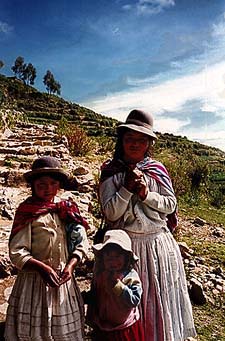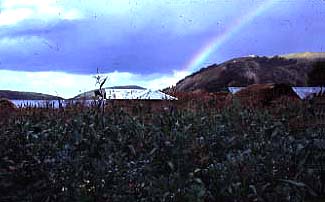The People of the Islands of the Sun and the
Moon
 The
Island of the Sun is divided into three communities: Yumani, Challa,
and Challapampa. It is difficult to know precisely how many people
live full time on the island, as many families now own houses and
businesses in La Paz, Bolivia's thriving and modern capital city, and
in Copacabana, the beautiful Inca and Colonial town on the lake shore
two to three hours away by boat. The latest census indicates a few
thousand people live or own property on the island.
The
Island of the Sun is divided into three communities: Yumani, Challa,
and Challapampa. It is difficult to know precisely how many people
live full time on the island, as many families now own houses and
businesses in La Paz, Bolivia's thriving and modern capital city, and
in Copacabana, the beautiful Inca and Colonial town on the lake shore
two to three hours away by boat. The latest census indicates a few
thousand people live or own property on the island.
For years, the Island of the Sun was controlled by two haciendas.
The 1950's revolutionary reforms that swept across Bolivia
redistributed the land to the farmers who actually worked it. Today,
all land on the island is privately or communally. You can see one
well preserved hacienda house in Yumani and the remains of the other
in the plaza of Challapampa.
The Island of Moon is considerably smaller than that of the Sun.
It currently supports between thirty and forty individuals. The
island was, until about thirty years ago, used as a prison for
political prisoners. Today, portions of the island are owned by the
villagers and other parts by the national government.
The people who live on the islands speak the Aymara language.
Aymara is also the name of their ethnic group. They are the
descendants of people who have lived on the islands for thousands of
years. While the islands are famous as places where the Inca built
major shrines to the Sun and the Moon, the people who live on them
are not descendant from the Quechua-speaking Inca peoples, but are
related to the aboriginal inhabitants who occupied the high Bolivian
plateau (the altiplano) when the Inca conquered the Titicaca.
The principal economic activities of the islanders today is
farming and fishing, a lifestyle that has predominated throughout
most of history. Visitors will see innumerable stone terraces on the
islands. Although difficult to date, it can be presumed that most of
the terraces were in use in Inca times, and many may even predate the
Inca. Traditional crops are still grown on these terraces, including
various types of potatoes, corn, and quinoa (a grain indigenous to
the Andean highlands). Many of the terraces may appear to be abandon,
but they are not. The fallow system of the islands requires that the
land rest 8 to 12 years between planting cycles.
 Besides farming most households earn an important part of their
income by fishing. The two most important commercial fish from the
lake are trout and pejerey. These fish are sold to venders in
Copacabana and La Paz. A number of islanders also own motorboats and
run transport businesses from Copacabana to ports on the islands. In
the last several years, the economy of Bolivia has stabilized
dramatically and grown, and there has been a concomitant increase in
tourism. Several hostels have opened on the Island of the Sun, and
there is a brisk tourist industry emerging in the region.
Besides farming most households earn an important part of their
income by fishing. The two most important commercial fish from the
lake are trout and pejerey. These fish are sold to venders in
Copacabana and La Paz. A number of islanders also own motorboats and
run transport businesses from Copacabana to ports on the islands. In
the last several years, the economy of Bolivia has stabilized
dramatically and grown, and there has been a concomitant increase in
tourism. Several hostels have opened on the Island of the Sun, and
there is a brisk tourist industry emerging in the region.
A visit to these islands in the late 20th century may be the last
opportunity to appreciate their unique ecological beauty. The islands
have no electricity or roads. There are no motorized vehicles of any
kind. As a result, the landscape has been untouched by modern heavy
construction. This situation will not continue, of course, as Bolivia
is rapidly developing an industrial infrastructure. The residents
want the best for themselves and their children and are actively
seeking electrification of the Island of the Sun. As tourism grows,
the number of people who visit these islands increase. The best time
to see the islands in their entirety is now.
Back to the Islands of the Sun and the Moon
Home Page
 The
Island of the Sun is divided into three communities: Yumani, Challa,
and Challapampa. It is difficult to know precisely how many people
live full time on the island, as many families now own houses and
businesses in La Paz, Bolivia's thriving and modern capital city, and
in Copacabana, the beautiful Inca and Colonial town on the lake shore
two to three hours away by boat. The latest census indicates a few
thousand people live or own property on the island.
The
Island of the Sun is divided into three communities: Yumani, Challa,
and Challapampa. It is difficult to know precisely how many people
live full time on the island, as many families now own houses and
businesses in La Paz, Bolivia's thriving and modern capital city, and
in Copacabana, the beautiful Inca and Colonial town on the lake shore
two to three hours away by boat. The latest census indicates a few
thousand people live or own property on the island. Besides farming most households earn an important part of their
income by fishing. The two most important commercial fish from the
lake are trout and pejerey. These fish are sold to venders in
Copacabana and La Paz. A number of islanders also own motorboats and
run transport businesses from Copacabana to ports on the islands. In
the last several years, the economy of Bolivia has stabilized
dramatically and grown, and there has been a concomitant increase in
tourism. Several hostels have opened on the Island of the Sun, and
there is a brisk tourist industry emerging in the region.
Besides farming most households earn an important part of their
income by fishing. The two most important commercial fish from the
lake are trout and pejerey. These fish are sold to venders in
Copacabana and La Paz. A number of islanders also own motorboats and
run transport businesses from Copacabana to ports on the islands. In
the last several years, the economy of Bolivia has stabilized
dramatically and grown, and there has been a concomitant increase in
tourism. Several hostels have opened on the Island of the Sun, and
there is a brisk tourist industry emerging in the region.